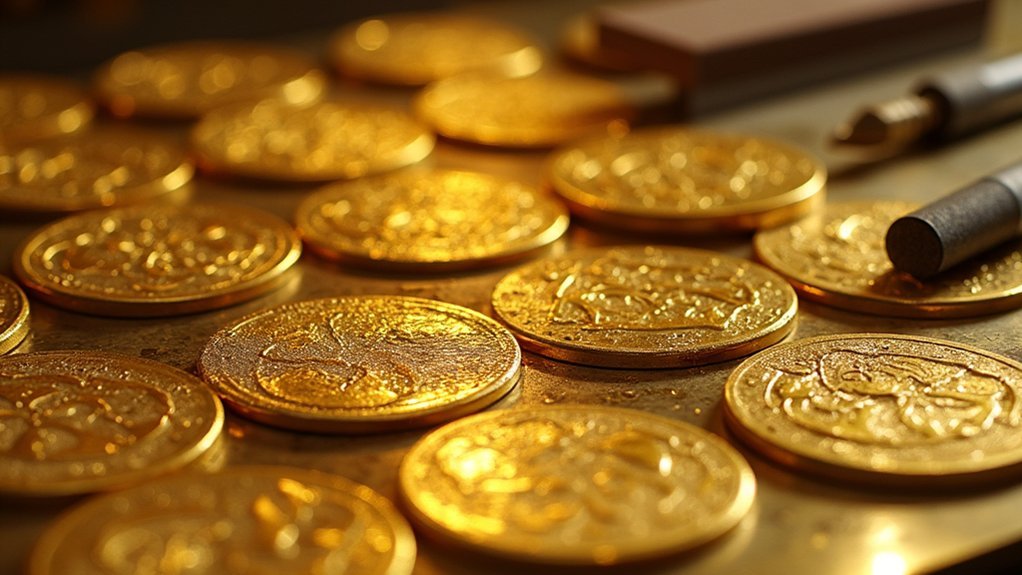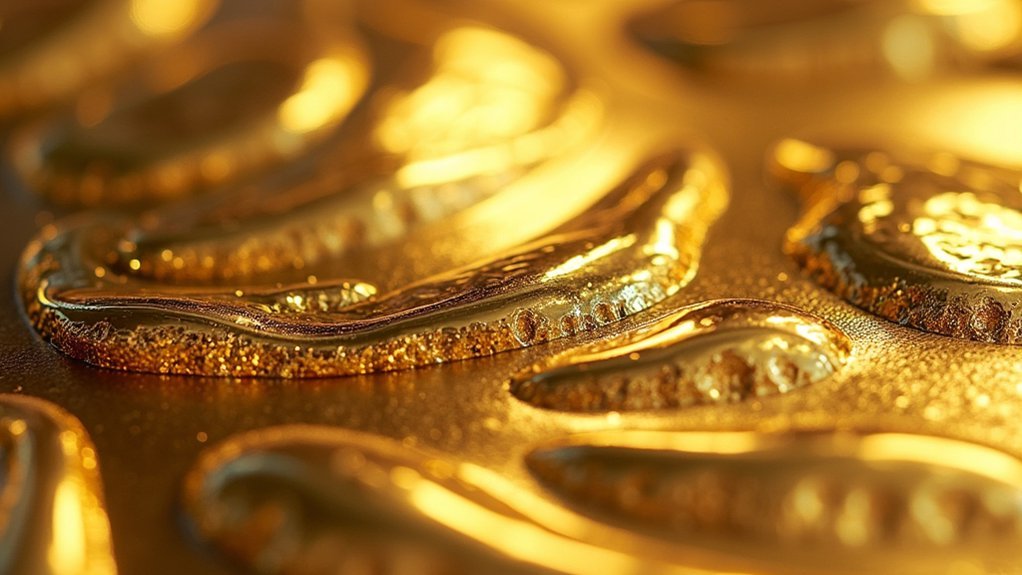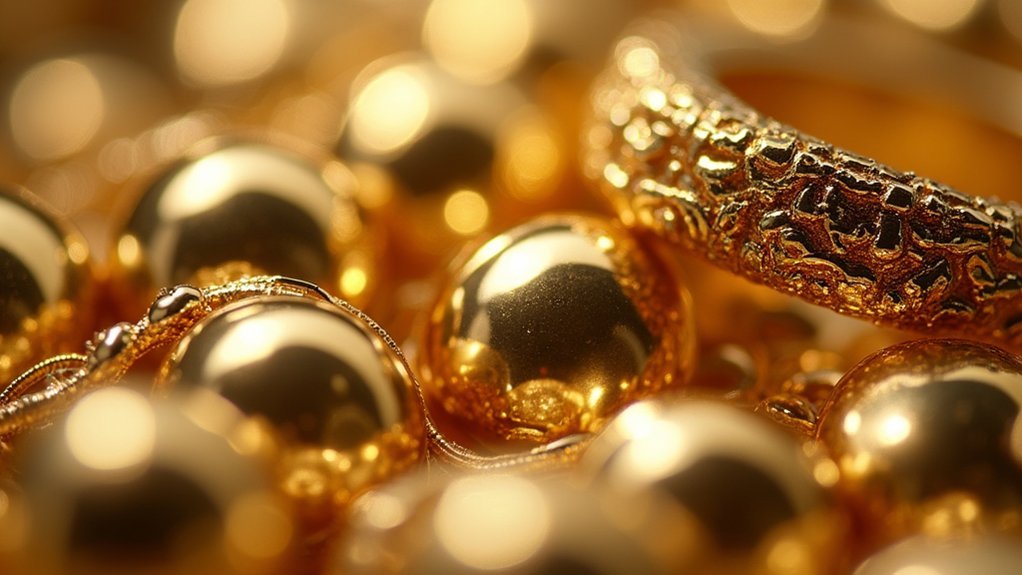You’ll achieve a perfect mirror finish on gold by mastering these five essential techniques. Start with thorough surface preparation using precise filing to eliminate deep scratches and imperfections. Progress through graded abrasives from 400 to 1200 grit, maintaining consistent directional movement. Apply hand polishing with tripoli and rouge compounds using clean tools between grades. Utilize power tools with appropriate mops for consistent results. Finally, employ burnishing techniques with high pressure to compress the gold surface. These methods work together to create that coveted reflective brilliance you’re seeking.
Surface Preparation and Filing Fundamentals

Before you can achieve that coveted mirror finish on your gold pieces, you must master the fundamentals of surface preparation and filing. Proper surface preparation eliminates deep scratches and imperfections that’ll mar your final appearance.
Master surface preparation and filing fundamentals first—eliminating deep scratches and imperfections is essential before attempting any mirror finish on gold.
You’ll need precise filing techniques using needle files for hard-to-reach areas, ensuring clean shaping before polishing begins.
Focus on creating neat solder joins and careful stone settings to reduce extensive filing requirements. Address fire scale, scratches, and marks left from previous work during this preparation stage.
Quality filing establishes the foundation for successful sanding, preventing sanding marks that compromise your precious metal’s integrity.
Progressive Sanding With Graded Abrasives
Once your filing work establishes a solid foundation, progressive sanding with graded abrasives becomes your pathway to that flawless mirror finish.
Start with 400-grit wet and dry sandpaper to eliminate deep scratches and fire scale, then advance through 600 and 1200 grits. Each sanding stage requires consistent directional movement to prevent cross-scratching that’ll compromise your final results.
This prep work demands patience—spending small amounts of extra time at each stage pays dividends later.
It’s a good idea to inspect your piece from multiple angles, ensuring no visible marks remain before advancing to finer grits. Achieve that satin appearance with your final grit before moving to polishing.
Hand Polishing With Compounds and Papers

Transform your satin-finished gold piece into a brilliant mirror surface through strategic hand polishing with compounds and papers. You’ll achieve the best results by following a systematic approach that builds upon your progressive sanding foundation.
Strategic hand polishing transforms satin-finished gold into brilliant mirror surfaces through systematic compound application and progressive technique refinement.
- Start with tripoli polishing compound for pre-polishing, then progress to rouge for high shine finishing.
- Attach polishing paper to a small piece of wood for stability and precise control over your piece of jewellery.
- Use clean, dry polishing mops between compound grades, changing direction to eliminate swirl marks.
- Apply polishing compound sparingly—just a small amount every 30-40 seconds maintains effective cutting action.
- Apply more pressure gradually as you work toward that coveted mirror finish, cleaning tools regularly to prevent cross-contamination.
Power Tool Polishing Methods
Power tools revolutionize the mirror-finishing process by delivering consistent, professional-grade results in a fraction of the time required for hand polishing.
When using power tool polishing methods, attach appropriate polishing mops to your rotary tool and select compounds like tripoli for pre-polishing and rouge for achieving that coveted high shine.
You’ll need distinct tools for each compound grade to prevent cross-contamination—never mix tripoli and rouge on the same mop.
Maintain high speeds throughout the process to maximize compound effectiveness and minimize surface damage.
Regularly inspect your gold piece during polishing to identify any remaining deep scratches and adjust your technique accordingly.
This systematic approach guarantees you’ll achieve a flawless mirror finish efficiently.
Burnishing for Ultimate Mirror Shine

Burnishing represents the final frontier in achieving an unparalleled mirror finish on gold pieces through the strategic application of high pressure and specialized tools. This technique compresses the gold’s surface using a hard burnisher, creating exceptional surface gloss and reflective finish quality.
- Apply consistent high pressure with your burnisher to compress the gold surface effectively.
- Focus on 24K gold pieces, which respond exceptionally well to burnishing techniques.
- Use a mirror-finished hammer as an alternative tool for achieving similar reflective results.
- Restore shine on daily-wear pieces by smoothing out micro-abrasions through regular burnishing.
- Complete meticulous polishing preparation before burnishing to eliminate existing scratches and imperfections.
You’ll find that burnishing transforms properly prepared surfaces into stunning mirror shine finishes that reflect light beautifully.
Frequently Asked Questions
How to Get Mirror Finish on Gold?
You’ll need to sand progressively through fine grits, then polish using tripoli followed by rouge on separate wheels. Use a burnisher with high pressure to compress the surface for maximum shine.
What Grit Gives a Mirror Finish?
You can’t achieve a true mirror finish with sandpaper alone. After progressing through 400, 600, and 1200 grit, you’ll need polishing compounds like tripoli and rouge to create that reflective surface.
How to Polish Bronze to a Mirror Finish Without Sanding?
Clean your bronze thoroughly, then apply jeweler’s rouge with a soft cloth using firm pressure. Burnish the surface systematically, finish with a quality polishing cloth, and maintain regularly to preserve the mirror finish.
How Do You Make Metal Shine Like a Mirror?
You’ll need to sand metal progressively through finer grits up to 1200, then apply polishing compounds like tripoli followed by rouge using rotary tools with polishing mops for consistent mirror-like results.
In Summary
You’ve now mastered the five essential techniques for achieving that coveted mirror finish on your gold pieces. Remember, there’s no shortcut to perfection – you’ll need to follow each step methodically, from proper surface preparation through final burnishing. Don’t rush the process, and you’ll be rewarded with brilliantly reflective gold that showcases your craftsmanship. Practice these methods consistently, and you’ll develop the skill to create stunning mirror-finish pieces every time.





Leave a Reply